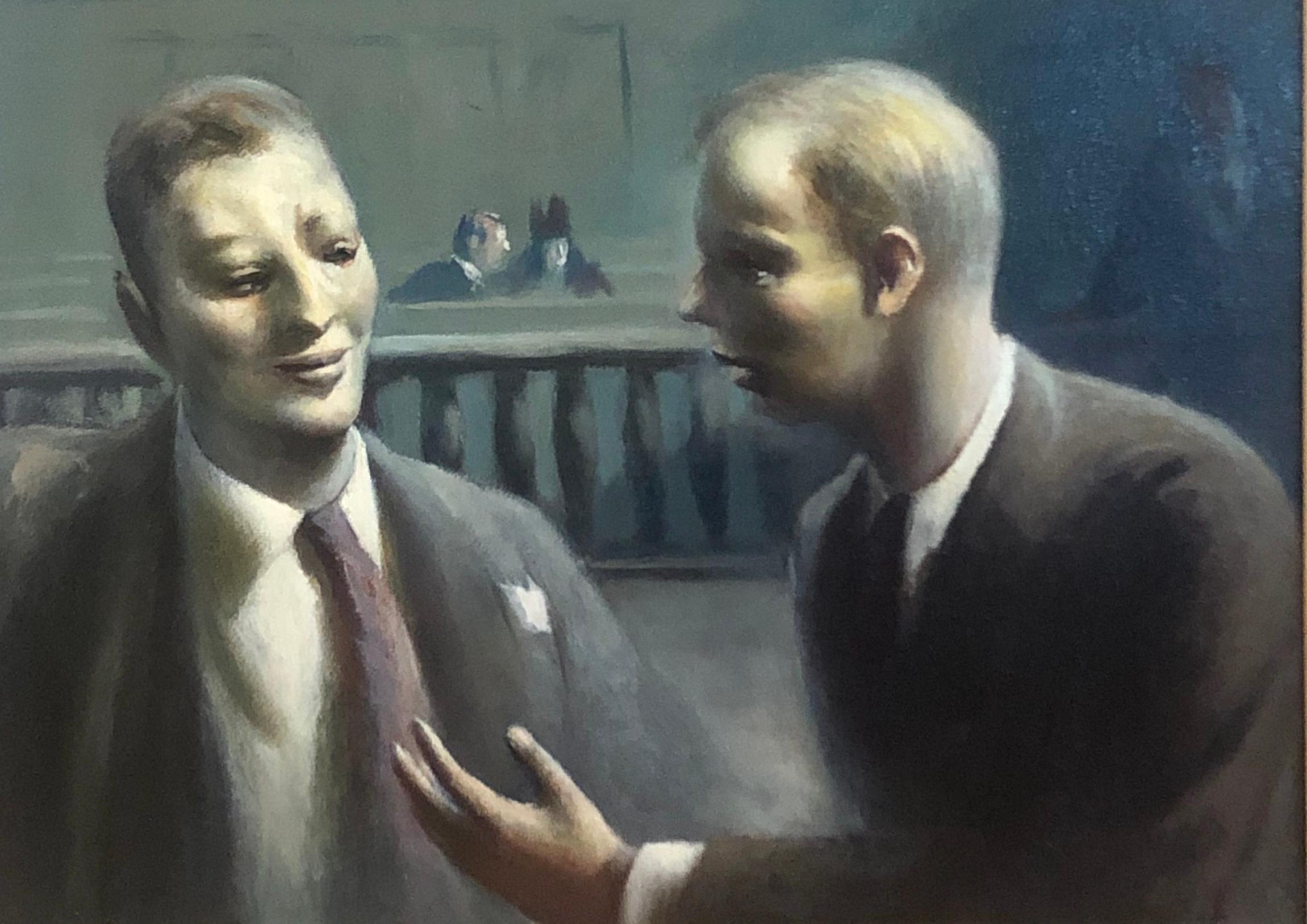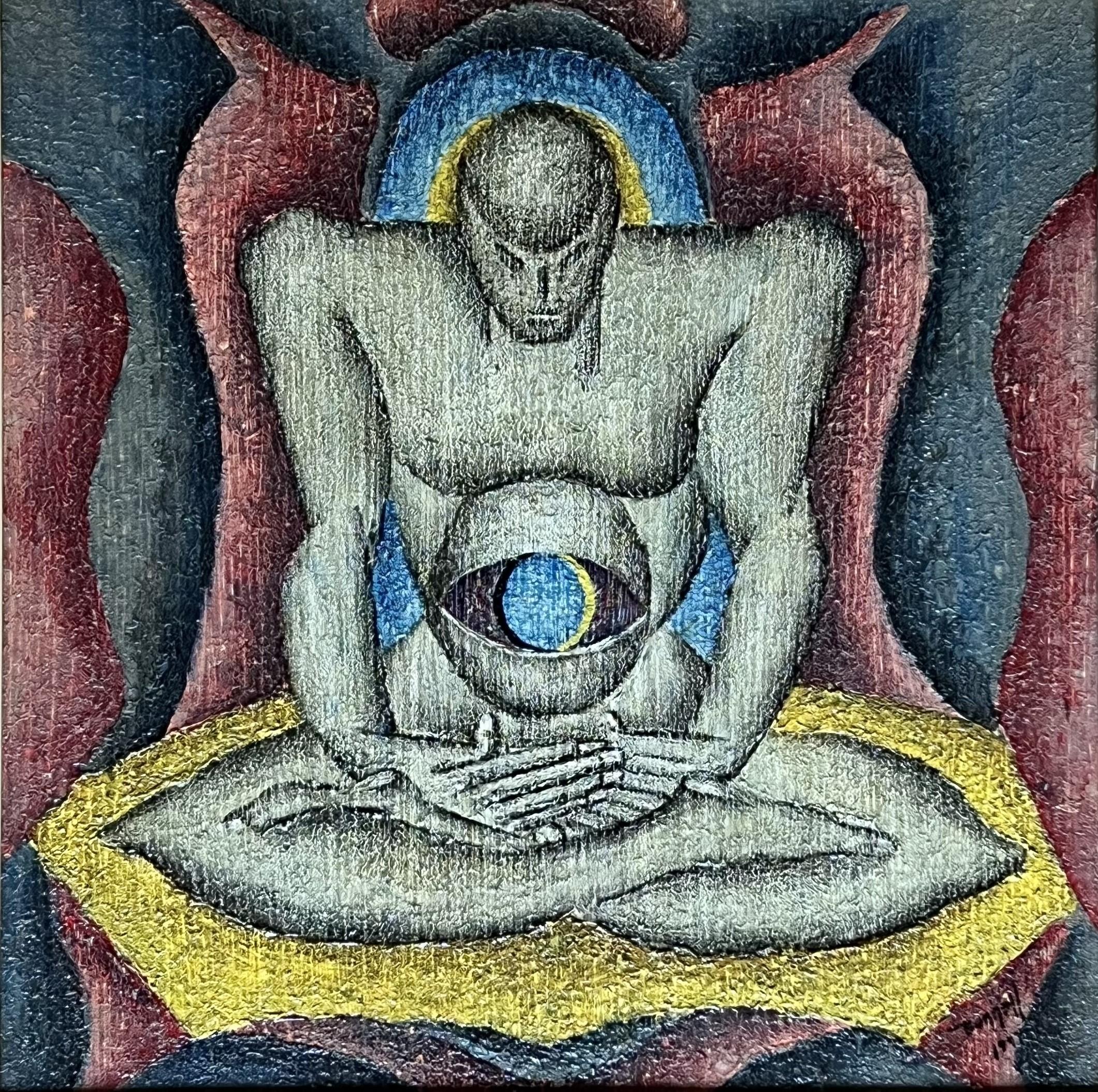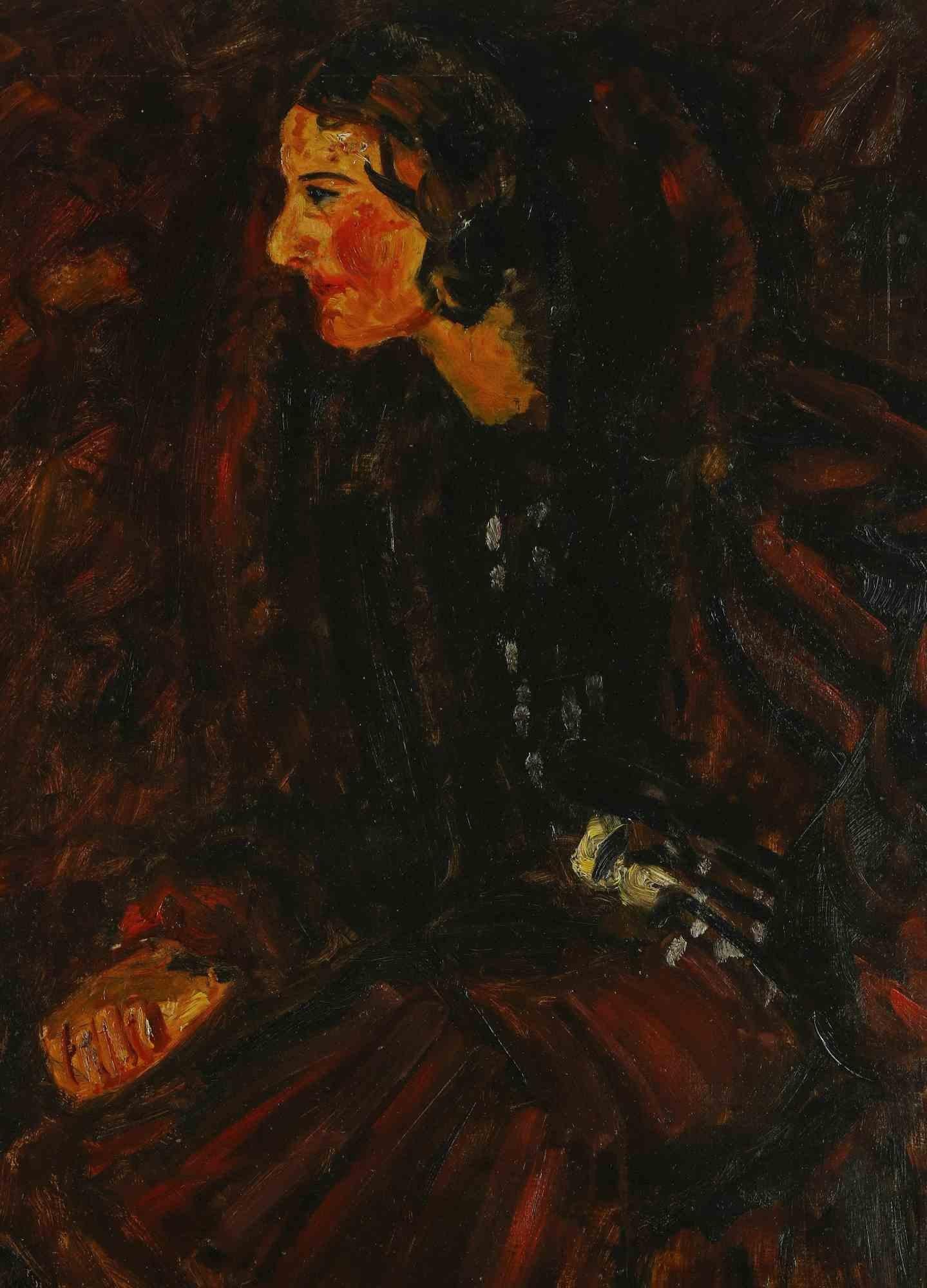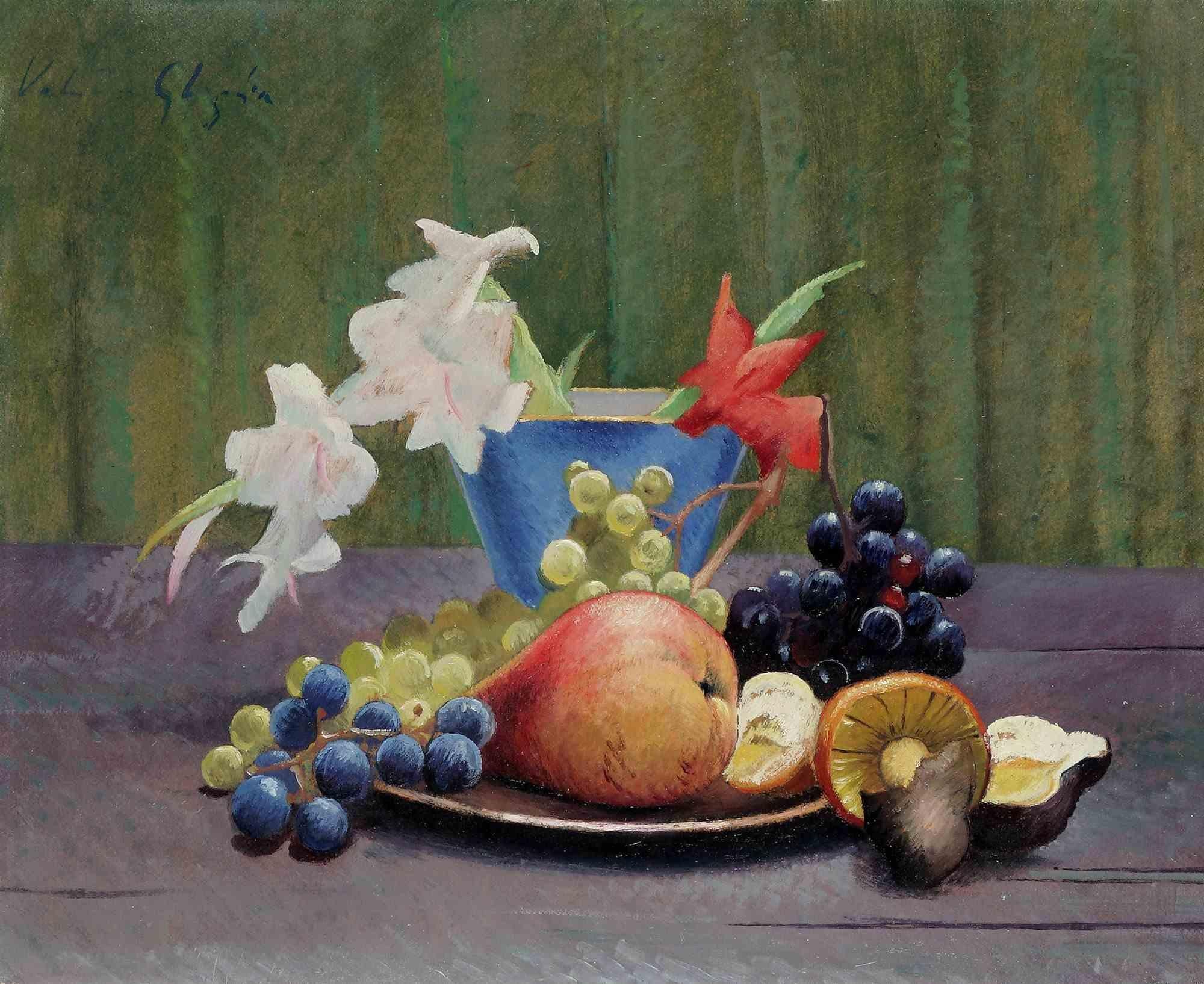Items Similar to Large American Modernist Judaica Oil Painting Rabbinic Discussion
Want more images or videos?
Request additional images or videos from the seller
1 of 11
Ervin B. NussbaumLarge American Modernist Judaica Oil Painting Rabbinic Discussion
About the Item
Ervin B. Nussbaum was born in Columbus, Ohio on November 11, 1914. His father, Marger, had arrived as part of the great Russian Diaspora of the time, when many Jewish families settled in Ohio, particularly in the Columbus area.
Nussbaum attended Ohio State University during the Great Depression and continued to live in Ohio until America’s involvement in World War II. His oil painting The End of John Brown, which depicts a fictionalization of the American abolitionist’s final hours, won first prize at the Central Ohio Competition in 1941. The piece then toured the country stopping at the San Francisco Museum, the Butler Art Institute, the Philadelphia Academy and the Corcoran Gallery. Donated in 2001, the painting is now part of the permanent collection at the Torrington Historical Society in Torrington, Connecticut, John Brown’s birthplace.
When the war began, Ervin, along with some 40,000 other men of all faiths, became part of the conscientious objector program known as the Civil Public Service. He spent the years 1942 through 1946 interned in government camps from New Hampshire to Maryland, working in public services such as forestry and hurricane cleanup. Many other objectors housed alongside him were of artistic inclination and shared Nussbaum’s conviction of peace, so artistic pursuits were common within these camps.
During these early years, his paintings followed a somewhat whimsical figurative style and leaned towards patriotic and Hebraic themes. In time, these themes began to take on an almost Cubist feel and eventually leaned toward complete abstraction.
Upon his release from his voluntary conscription as a CPS, Nussbaum moved to New York where he frequently painted semi-abstract landscapes in the local parks, throughout the New England countryside, and at the shorelines. He especially enjoyed painting in the woodland tranquility of Inwood Park in northern Manhattan. He paid special attention to the park’s bird life, which would soon become a new favorite subject. Their graceful movement inspired his creation of a series of avian sculptures in wood, metal or mixed medias.
In 1951, he met the dynamic young actress, playwright, musician, and graphic artist Muriel Leventhal. They married and moved to Norwalk, Connecticut in 1959. Nussbaum continued to work in a variety of media and showed regularly in many different galleries throughout Connecticut. His bronze sculptureThree Girls on a Flower was commissioned by the Trumbull Library and a wood bas-relief was created for the sanctuary at the Yonkers Temple Emanuel. Nussbaum would remain in Norwalk until his death in 1996.
When contemplating the work of Ervin Nussbaum, we find the soul of a man set in principles of profound religious and patriotic convictions as well as a deep abiding love of nature. His art shows us the evolution of the man through the evolution of the styles he undertook during his lifetime; from figurative, to cubist, to complete abstraction; from oils, to charcoal, to a mixture of media. His works are left to us in museums across the United States, as well as in countless private collections in the U.S. and abroad.
- Creator:Ervin B. Nussbaum (1914-1996, American)
- Dimensions:Height: 48 in (121.92 cm)Width: 30 in (76.2 cm)
- Medium:
- Movement & Style:
- Period:
- Condition:Minor wear, small area of imperfection in canvas. selling unframed.
- Gallery Location:Surfside, FL
- Reference Number:1stDibs: LU38210806572
About the Seller
4.9
Platinum Seller
These expertly vetted sellers are 1stDibs' most experienced sellers and are rated highest by our customers.
Established in 1995
1stDibs seller since 2014
1,549 sales on 1stDibs
Typical response time: 1 hour
- ShippingRetrieving quote...Ships From: Surfside, FL
- Return PolicyA return for this item may be initiated within 3 days of delivery.
More From This SellerView All
- Rare Israeli Modernist Oil Painting Exhibited 1951 Tel Aviv MuseumBy Anatol GurevitchLocated in Surfside, FLGurevich Anatole Anatol Gurevitch Anatol Gurewitsch (1916-2005) Per the hebrew label on the back, this was exhibited in 1951. I believe at the Tel Aviv museum of art (as per the Israel Museum (Jerusalem) website)m in a manner reminescent of Bezalel Schatz, Moshe Castel, Jean david and other Israeli artists of the New Horizons prominent in that period ts a nude crouching figure against a colorful abstract background. Israeli Painter and stage designer. Yakir of Tel Aviv. Born in Russia, Moscow in the mid-teens of the twentieth century. Studied painting in Berlin. Immigrated to Palestine from Germany in 1934. Served in the British Army (1941-1946). Known for his pantings of Jewish rabbis and other Judaica subject matter. He specialized in stage design for dance troupes: the dance troupe led by Gertrude Kraus, Inbal, the Batsheva Dance Company, the international black dancer tali bati. His first wife was the late dancer and choreographer - the girl Kesten, His son is theater director Michael Gurevich. His second wife was the actress - Rivka Gur, who gave birth to his second son, Eyal. He died at the age of 89 after a serious illness. He left behind two sons: Michael (Miki) Gurevitch and Eyal Gurevitch. He was the uncle of the artist and sculptor - Igael Tumarkin. He was a stage designer in the theaters The brothel of Hunzo from Kibbutz Givat Haim, the British military band of this type, the British army, Gertrud Kraus, the Inbal Dance Theater, the Israeli Ballet, the Batsheva Dance Company and more. He designed a stage for plays The girl and the Negro, the Threepenny Opera, a band on the Thames, the singer of the land (in the military band of 1944), the banknote to Shlomo, the tea department, Nathan the Wise, Herod and Miriam. Awards Yakir Tel Aviv Prize, on behalf of the Tel Aviv Municipality. Anatol Gurewitsch, painter and Stage designer, born 1916, Moscow. After Second World War worked as stage designer. Designed costumes for dancer Gertrud Krausz. Uncle of Igael Tumarkin, and father of the theater Director Miki Gurewitsch. Education Academy of Fine Arts, Berlin, art 1936 with Frenel Frankel 1937 with Miron...Category
1940s Modern Figurative Paintings
MaterialsOil, Board
- 1950s Academic Realistic Study of Hands Oil Painting Signed Stuart WhyteLocated in Surfside, FL1950s Academic Realistic Study of Hands Oil Painting Signed Stuart Whyte In the manner of Auguste Rodin.Category
1950s Modern Figurative Paintings
MaterialsOil, Board
- Large Modernist Oil Painting 1940s, Judaica Hasidic Shtetl Wagon Driver WPA EraBy Emanuel Glicenstein RomanoLocated in Surfside, FLGenre: Modern Subject: Landscape with figure of horse, driver and wagon Medium: Oil Surface: wood Board EMANUEL ROMANO Rome, Italy, b. 1897, d. 1984 Emanuel Glicen Romano was born in Rome, September 23, 1897. His father Henryk Glicenstein was a sculptor and was living in Rome with his wife Helena (born Hirszenberg) when Emanuel was born. His father obtained Italian citizenship and adopted the name Enrico. Emanuel was brought up in Italy, Switzerland, Germany, England and Poland. In 1926 Emanuel Glicenstein Romano and his father sailed for New York. They briefly visited Chicago. Romano's sister, Beatrice, and mother only joined them in New York years later. Romano changed his name on his arrival to America and some have erroneously speculated that this was to avoid antisemitic discrimination. In truth, as the son of a highly-regarded artist, Romano changed his name to ensure that any success or recognition he would later attain, would be the result of nothing other than his own merit as an artist, and not on account of his father's fame. In 1936 Romano was worked for the WPA Federal Art Project creating murals. ( there were many jewish artists active with in the WPA period. notably Chaim Gross, Ben Shahn, Isaac and Moses Soyer, Abraham Rattner and many others. During and immediately after World War II, Romano created a series of allegorical works depicting graphic holocaust images that were held closely by the family until after his passing. One of these works is now on permanent display in the Florida Holocaust Museum in St. Petersburg Florida. Emanuel's father died in 1942 in a car accident before they could realize their shared dream of visiting Israel. In 1944 Romano, having completed his degree at the Pennsylvania Academy of Fine Arts and the Art Institute of Chicago, began teaching at the City College of New York. Romano moved to Safed, Israel in 1953 and established an art museum in his father's memory, the Glicenstein Museum. COLLECTIONS Indianapolis Museum of Art Metropolitan Museum of Art Boston Fine Arts Museum Fogg Museum Musée Nacional de France Recently his work has been added to the Florida Holocaust Museum collection. His notable works include his holocaust themed allegorical paintings as well as portraits of Marianne Moore, his father and William Carlos Williams...Category
1930s American Modern Figurative Paintings
MaterialsOil, Board
- Judaica Oil Painting Jewish Family Interior Shtetl SceneBy Peter HorowitzLocated in Surfside, FLPeter Horowitz, painter, born 1922, Poland. Lived in Hod Hasharon in Israel. Studied at the Art Academy, Krakow. died in 2005. Studies: Art Academy, Cracow. Peter Horowitz was born...Category
Mid-20th Century Modern Figurative Paintings
MaterialsOil, Board
- Modernist Oil Painting 1940s, Judaica Hasidic Rabbi in JerusalemBy Emanuel Glicenstein RomanoLocated in Surfside, FLGenre: Portrait Subject: Landscape Medium: Oil Surface: Board Country: United States EMANUEL ROMANO Rome, Italy, b. 1897, d. 1984 Emanuel Glicenstein Romano was born in Rome, September 23, 1897. His father Henryk Glicenstein was a sculptor and was living in Rome with his wife Helena (born Hirszenberg) when Emanuel was born. His father obtained Italian citizenship and adopted the name Enrico. Emanuel was brought up in Italy, Switzerland, Germany, England and Poland. In 1926 Emanuel and his father sailed for New York. They briefly visited Chicago. Romano's sister, Beatrice, and mother only joined them in New York years later. Romano changed his name on his arrival to America and some have erroneously speculated that this was to avoid antisemitic discrimination. In truth, as the son of a highly-regarded artist, Romano changed his name to ensure that any success or recognition he would later attain, would be the result of nothing other than his own merit as an artist, and not on account of his father's fame. In 1936 Romano was worked for the Federal Art Project creating murals. During and immediately after World War II, Romano created a series of allegorical works depicting graphic holocaust images that were held closely by the family until after his passing. One of these works is now on permanent display in the Florida Holocaust Museum in St. Petersburg Florida. Emanuel's father died in 1942 in a car accident before they could realize their shared dream of visiting Israel. In 1944 Romano, having completed his degree at the Pennsylvania Academy of Fine Arts and the Art Institute of Chicago, began teaching at the City College of New York. Romano moved to Safed, Israel in 1953 and established an art museum in his father's memory, the Glicentein Museum. COLLECTIONS Indianapolis Museum of Art Metropolitan Museum of Art Boston Fine Arts Museum Fogg Museum Musée Nacional de France Recently his work has been added to the Florida Holocaust Museum collection. His notable works include his holocaust themed allegorical paintings as well as portraits of Marianne Moore, his father and William Carlos Williams...Category
1970s American Modern Figurative Paintings
MaterialsOil, Board
- The Preacher Rabbi "Der Maggid" Judaica Oil Painting WPA Jewish artistBy Maurice KishLocated in Surfside, FLGenre: Modern Subject: Hasidic Rabbi preaching in Synagogue Medium: Oil Surface: Board, size includes artist decorated frame Country: United States The imagery of Maurice Kish (189...Category
Mid-20th Century Modern Figurative Paintings
MaterialsOil, Board
You May Also Like
- Icon - Painting - 19th centuryLocated in Roma, ITIcon is an artwork realized in the 19th century by Anonymous artist. Mixed colored encaustic painting on panel. The artwork depicts a religious scene, following the tradition of re...Category
19th Century Modern Figurative Paintings
MaterialsBoard, Oil
- Guy Pene du Bois WPA American Modernism Realism NYC Scene Oil Lawyers in CourtBy Guy Pène Du BoisLocated in New York, NYGuy Pene du Bois' "Two Figures in Courtroom" is a WPA era American scene oil painting created in a realistic style. Modernism at its best The work is framed by Heydenryk. Pène du Bois descended from French immigrants who settled in Louisiana in 1738 and was raised in a Creole household. He was born in 1884 in Brooklyn, NY and first studied with William Merritt Chase at the New York School of Art and later continued his training with Robert Henri. Pène du Bois was greatly impressed with Henri's credo that "real life" was subject matter for art and throughout his life a realist philosophy informed his art as well as his parallel career, art criticism. In 1905, Pène du Bois made his first visit to Paris where he painted scenes of fashionable people in cafes rendered in the dark tonalities and impasto associated with the Ashcan School. By 1920, he had achieved his mature style, which was characterized by stylized, rounded, almost sculptural figures painted with invisible brushstrokes. The subjects of his paintings were often members of society whom he gently satirized. In 1924, Pène du Bois and his wife, Floy, left for France where they would remain until 1930. Returning to America showcases pictures the artist produced after this very productive period abroad. After five years of living in France, Pène du Bois was able to observe American life with fresh eyes. His work becomes more psychologically intense and less satirical. In Girl at Table a slender, blond is shown gazing at a small statue that she holds at arm's distance. The meaning is elusive, but a powerful sense of longing is evoked. Similarly, paintings such as Dramatic Moment and Jane are taut with unresolved dialogue. Both pictures depict mysterious interiors in which a lone woman anxiously awaits the denouement of a suspenseful scene. Other pictures, for example, Chess Tables, Washington Square and Bar, New Orleans, recall Pene du Bois's Ashcan origins in their depiction of urban entertainment. During this period, landscape becomes an important subject for Pène du Bois. Girl Sketching...Category
1930s American Modern Figurative Paintings
MaterialsPaper, Oil, Board
- Untitled (Transcendental Composition)By Charles Ragland BunnellLocated in Los Angeles, CAThis work is part of our exhibition - America Coast to Coast: Artists of the 1940s Untitled (Transcendental Composition), oil on board, 1947, oil on board, signed and dated lower r...Category
1940s American Modern Paintings
MaterialsOil, Board
- Woman - Oil Painting on Canvas by Antonio Feltrinelli - 1920sLocated in Roma, ITWoman is an orignal modern artwork realized by Antonio Feltrinelli in 1920s. Mixed colored oil painting on board. Not signed. Antonio Feltrinelli (Milan, 1887 – Gargnano, 1942) H...Category
20th Century Modern Figurative Paintings
MaterialsBoard, Oil
- Still Life - Oil on Cardboard by Valentino Ghiglia - Mid-20th CenturyBy Valentino GhigliaLocated in Roma, ITStill Life is an artwork realized by Valentino Ghiglia in the Mid-20th Century. Oil on Cardboard, cm 46x57. Hand signed on top left. Very good condition.Category
Mid-20th Century Modern Still-life Paintings
MaterialsOil, Cardboard, Paper
- Russian Musicians - Oil painting by L. M. Brailovsky - Early 20th CenturyLocated in Roma, ITRussian Musicians is an original painting, realized by Leonid Mikhailovich Brailovsky in the Early XX century Oil painting on board. Hand-signed by the artist on the lower margin. I...Category
Early 20th Century Modern Figurative Paintings
MaterialsOil, Board
Recently Viewed
View AllMore Ways To Browse
Early American Oil Painting
New Large Oil Painting
Large Vintage Oil Painting Paintings
Foral Modernist Paintings
Oil Paintings Modernist
Large Modern Oil Paintings
World War Oil Painting
Modernist Oil Paint
American Modernist Paintings
American Art Paintings Of New England
Large Painting Of War
Oil Paintings Philadelphia
World War Ii American
Figurative Historical Paintings
Oranges Paintings Large
Early Modernist Painting
Graphic Painting Large
Library Oil Painting




